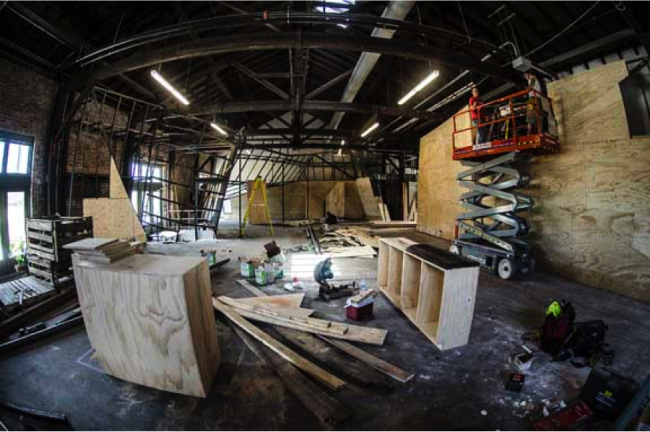
By Joe Robinson
Picture roaming livestock on lush rolling hills flattening to rows of wheat swaying in the breeze as far as the eye can see. Picture open roads slicing wide green fields like outfield foul lines to connect pockets of gas stations which fuel engulfing farms. Picture a rock climber stepping out of a hatchback loaded with climbing gear to fill up at one of these pumps…and double-check Siri’s directions.
If you are like us, then Kansas only comes to mind in climbing discussions as a 400-plus mile rock-less wasteland to be endured on a road trip to the breathtaking mountains of Colorado. But the planned openings of three new Kansas climbing gyms in addition to the two existing climbing facilities in Wichita and western Kansas City – as well as two gyms on the Missouri side of Kansas City – suggest climbers are breathing regularly in the “Breadbasket of the World” and pinning Kansas addresses in their Smartphones as destinations instead of departures.
After speaking with leaders from four of the seven Kansas climbing gyms, the impression comes through that the rapid gym development in Wichita and Kansas City depends on both Kansas-specific and non-Kansas-specific causes. While Kansas does not offer much in the way of outdoor rock climbing (Rockclimbing.com lists a mere 10 routes for Kansas, the second fewest of all continental states), the topography, economy and culture of Kansas do afford a few advantages for indoor gyms.
First, and perhaps most significantly, there is some upside to being what
National Geographic says is the seventh flattest state in the union, a benefit that could be called “the Midwest Paradox.” On the one hand, yes, outdoor rock climbing is nearly impossible to do in Kansas unless you bring a boulder with you. On the other hand, the absence of mountainous terrain requires Kansas adventure enthusiasts to rely more heavily on indoor businesses like climbing gyms for thrills. The absence of rocks to climb actually INCREASES the quantity of indoor rock climbers. This is the Midwest Paradox. “We are one of the flattest states in the union, and the closest climbing is 6 hours from us in Arkansas,” says David Kortje, owner of
Bliss Bouldering and Climbing Complex, a full-scale gym set to open in November in Northeast Wichita. “From that standpoint, it’s a positive. We are going to be the new thing in town, the exciting thing that everyone is talking about,” he said.
Second, it’s one thing to desire adventure sports and quite another thing to have a place to enjoy them. Building a gym requires money, and if a lot of money does not come from a few hands then a little money must come from many hands. Fortunately for Kansas climbers, the communal culture of their state is conducive to the latter should large investments fall short. “I think part of it is the co-op mindset,” says Paul Polk, longstanding president of the
Kansas Cliff Club climbing co-op, when asked about the elements which led to the climbing club’s creation in Southeast, Wichita. “Everything out here is done because the members have done it, from land to plumbing to building the wall to making the holds and the molds. We did all of it,” he said. In Midwestern states like Kansas where rock climbing is not a mainstream sport, pooling member resources may be a necessity for creating climbing gyms.
Lastly, climbing gym entrepreneurs in Kansas wishing to start for-profit gyms have benefited from recent economic development in their regions. Like many states, Kansas is experiencing significant economic growth following the Second Great Depression. According to the
2014 Kansas Economic Report by the Kansas Department of Labor, after a 4% decrease in real GDP in 2009 the state of Kansas witnessed four consecutive years of growth, and the leisure industries enjoyed some of that growth. “Wichita is divided into the East and West, and both sides are progressing,” says Kortje, who strategically located Bliss amidst a growing recreational complex he refers to as “a sports mecca” which “supports the edgier side of life.” Economic development in this area, then, has given Wichita adventure enthusiasts another island of plastic bliss (pun intended) on which to release their Plains-bound energy.
Exit: AnyMetro, USA
The same economic growth in the adventure sports industry is true for Kansas City. “When the economy went down…people got smarter about how to spend their money” says Elsa Bleeker, an avid businesswoman and owner of The
Cave Bouldering Gym in Kansas City, Missouri, a unique underground gym literally located ten stories beneath the Earth’s surface in the old mines of downtown Kansas City. “Instead of going on one vacation a year that costs a lot of money, they are looking for more adventure-based activities to do all year round,” she said. Bleeker is now starting a second gym on the Kansas side of Kansas City, Apex Climbing Gym in Overland Park, alongside Apex co-owner Phil Ratterman. The full-scale gym is set to open its doors in June. However, other phenomena not related to Kansas specifically also play a role in the rise of climbing gyms in Kansas City.
For one, Kansas City is a high-density metropolis. “Most metropolitan areas have a higher ratio of climbing gyms per capita,” says Ratterman. The reason why is simple: the more people living in any given area, the greater the number of potential customers. What’s more, a high proportion of the Kansas City population are of the climbing demographic. “Johnson County is rated fairly high in density of people who are family age and workers,” continues Ratterman about the county in which Overland Park is located. “That age range is good for climbers.” When it comes to populations conducive for indoor climbing, though, any metropolis could provide such parameters.
On another matter related to population density, large cities are often hard to navigate. Transportation from one side of a metropolis to the other can take hours during rush hour. Thus, metropolitan areas often host a greater number of climbing gyms than non-metropolitan areas because customers prefer to spend their time in the gym rather than the car. Again, the math is simple: the worse the transportation in an area, the more a customer will wish to climb at a nearby location. “The city is pretty spread out,” says Bleeker, “so the travel time and the density of people allow for the creation of multiple gyms.” Improved transportation systems would solve this problem, but for now substantial transportation hours is a factor encouraging the spread of gyms in metropolitan areas like Kansas City.
Finally, climbing gyms in both Wichita and Kansas City are benefiting from another element which could be found in any American city of decent size: diversity. Like all consumers, climbers have different tastes and preferences; some climbers prefer family-oriented multiple-use gyms, others prefer a strong community of like-minded V-crushers. Thus, in areas with high concentrations of climbers, gyms can create a niche market by specializing in a particular brand of the sport. In Kansas City, Apex appeals to climbers with the former set of preferences. “On the clientele side, a lot of people want to do things as a family,” says Ratterman. “On the business side, we want to create a unique experience for people.” Ratterman mentioned the desire to offer yoga and crossfit classes, ninja obstacle courses, youth climbing opportunities and family nights in addition to open bouldering and top-rope climbing.
By contrast, The Cave primarily caters to climbers with the latter set of preferences. “It’s easier to be a part of the community at a small gym that is less expensive,” says Bleeker, “so there’s always going to be a place for smaller, local gyms just like there is a place for local crags.” The same phenomenon is occurring in Wichita, with Bliss offering a full-range of activities and the Kansas Cliff Club offering climbing only. Gym specialization in Wichita and Kansas City, therefore, is creating a niche for each gym and divvying up the market accordingly which enables the existence of multiple climbing locales.
The development of Kansas climbing gyms is an important reminder for gym hopefuls in Midwestern and other relatively rock-free states to keep in mind what Ratterman says: “You don’t have to have a climbing mecca to have a climbing gym.”
Departure: Where are they going?
As with all business development analysis, the question is not merely why businesses come into existence but the sustainability of such. Can the Kansas climbing gym market sustain the entrance of three new gyms? Will all climbing gyms be profitable or will some gyms lose out? Economists are not weathermen and, after experiencing both Great Lakes and mountain weather, we would not trust economic predictions even if forecasts were made. But economics can help us model the parameters of the problem so we don’t wear shades of ignorance in a tidal wave of complex market variables.
Given the causes previously described, one could model Wichita and Kansas City climbing gym markets in economic terms as oligopolies with horizontally differentiated products. In simplest form, a market can be classified by quantity, or the number of firms in a market, and quality, the type of products firms sell. When it comes to quantity, these Kansas climbing gym markets are oligopolies – as opposed to monopolies, markets with only one firm, and perfectly competitive or monopolistic markets, markets with many firms – since both markets are comprised of only a few climbing gyms, with Wichita set to become a duopoly shortly (an oligopoly with just two firms). As for quality, these oligopolies are horizontally differentiated products oligopoly markets – as opposed to vertically differentiated products oligopoly markets, markets in which consumers consider a product to be superior in performance to another, and homogenous products oligopoly markets, markets in which firms sell virtually the same products – since both markets are comprised of climbing gyms that sell distinctively different products to niche markets in which consumers view a nearby gym as a poor substitute for their preferred gym, even at a lower price.
Classifying the Kansas gym market as such allows us to model the behavior of climbers and gyms therein and, ultimately, the effects of development on gym profits. As for the behavior of gyms, according to Bertrand’s model of price competition with horizontally differentiated products, monopoly prices ought to decrease with the entrance of another firm. Climbing gyms may not be as competitive as other businesses, but they are also not immune to competition. “Business is business, no matter what the business is,” says Bleeker. Assuming owners are not acting as a cartel and cooperating on prices, then an increase in climbing gyms ought to increase competition and the desire to undercut competitors’ prices to lure climbers away from nearby gyms, thereby decreasing climbing gym prices in both Wichita and Kansas City.
However, how much prices decrease depends upon the extent to which climbing gyms affect the loyalty of their customers by differentiating their products. Economists use a fancy term for how sensitive consumer demand is for one good or service relative to the price change of another substitutable good or service: cross-price elasticity of demand. In general, the lower the elasticity, the less effect a price change in another good or service will have on consumer demand for a given product. Specialization should decrease the cross-price elasticity of demand. “It’s hard for us to imagine being a part of a gym where we aren’t a part of the inner workings,” Polk says. Thus, the more a gym distinguishes its product for example, the more loyal its customers become, and the softer the price competition between facilities because gyms know a price change will have little effect on gym demand.
In regards to the behavior of gym customers, the introduction of a new gym ought to decrease the demand for the existing gym. Should the industry demand for indoor climbing in the area remain constant, as more gyms enter the market, existing gyms should be able to retain loyal climbers but some climbers will inevitably become loyal to the new gym(s), resulting in a decrease in that gym’s demand. “We’ve looked at it as if we are trying to draw from the same finite space,” says Polk. “So we’ve never put zero efforts into marketing.” Should an incumbent gym’s demand drop below the demand necessary to cover fixed operating costs, that gym may have to raise prices simply to stay in business. A price increase would test the loyalty of its niche clientele: will they pitch in to save their home gym?
However, an entrant advertises not only for itself but also for the sport of climbing in general which increases entire industry demand at no cost to the incumbent. Some of this additional demand will inevitably cross over onto a rival’s turf. “The more gyms there are, the more exposure all gyms get,” says Bleeker. “One gym advertises for another gym.” Whether an existing gym, then, loses or gains climbers will depend on the ratio between how much industry demand an entrant creates and how much per gym demand an entrant relocates.
What is to be said of profits, then? As a total sum, the introduction of three new gyms to Wichita and Kansas City will increase industry profits which can only be good for the sport of climbing in Kansas. The movement of per gym profits in the long run and the sustainability of Kansas climbing gyms, however, we have shown is a bit more complex and depends upon how much the entrant(s) shifts demand and to whom, the personal preferences of Kansas climbers, the type and quality of service each gym provides and at what cost, as well as the movement of gym prices. Only one thing is certain:
They are coming.
Let us therefore hope Bleeker’s words are true: “There is enough to share; there is enough to go around.”
 By Joe Robinson
Picture roaming livestock on lush rolling hills flattening to rows of wheat swaying in the breeze as far as the eye can see. Picture open roads slicing wide green fields like outfield foul lines to connect pockets of gas stations which fuel engulfing farms. Picture a rock climber stepping out of a hatchback loaded with climbing gear to fill up at one of these pumps…and double-check Siri’s directions.
If you are like us, then Kansas only comes to mind in climbing discussions as a 400-plus mile rock-less wasteland to be endured on a road trip to the breathtaking mountains of Colorado. But the planned openings of three new Kansas climbing gyms in addition to the two existing climbing facilities in Wichita and western Kansas City – as well as two gyms on the Missouri side of Kansas City – suggest climbers are breathing regularly in the “Breadbasket of the World” and pinning Kansas addresses in their Smartphones as destinations instead of departures.
After speaking with leaders from four of the seven Kansas climbing gyms, the impression comes through that the rapid gym development in Wichita and Kansas City depends on both Kansas-specific and non-Kansas-specific causes. While Kansas does not offer much in the way of outdoor rock climbing (Rockclimbing.com lists a mere 10 routes for Kansas, the second fewest of all continental states), the topography, economy and culture of Kansas do afford a few advantages for indoor gyms.
First, and perhaps most significantly, there is some upside to being what National Geographic says is the seventh flattest state in the union, a benefit that could be called “the Midwest Paradox.” On the one hand, yes, outdoor rock climbing is nearly impossible to do in Kansas unless you bring a boulder with you. On the other hand, the absence of mountainous terrain requires Kansas adventure enthusiasts to rely more heavily on indoor businesses like climbing gyms for thrills. The absence of rocks to climb actually INCREASES the quantity of indoor rock climbers. This is the Midwest Paradox. “We are one of the flattest states in the union, and the closest climbing is 6 hours from us in Arkansas,” says David Kortje, owner of Bliss Bouldering and Climbing Complex, a full-scale gym set to open in November in Northeast Wichita. “From that standpoint, it’s a positive. We are going to be the new thing in town, the exciting thing that everyone is talking about,” he said.
Second, it’s one thing to desire adventure sports and quite another thing to have a place to enjoy them. Building a gym requires money, and if a lot of money does not come from a few hands then a little money must come from many hands. Fortunately for Kansas climbers, the communal culture of their state is conducive to the latter should large investments fall short. “I think part of it is the co-op mindset,” says Paul Polk, longstanding president of the Kansas Cliff Club climbing co-op, when asked about the elements which led to the climbing club’s creation in Southeast, Wichita. “Everything out here is done because the members have done it, from land to plumbing to building the wall to making the holds and the molds. We did all of it,” he said. In Midwestern states like Kansas where rock climbing is not a mainstream sport, pooling member resources may be a necessity for creating climbing gyms.
Lastly, climbing gym entrepreneurs in Kansas wishing to start for-profit gyms have benefited from recent economic development in their regions. Like many states, Kansas is experiencing significant economic growth following the Second Great Depression. According to the 2014 Kansas Economic Report by the Kansas Department of Labor, after a 4% decrease in real GDP in 2009 the state of Kansas witnessed four consecutive years of growth, and the leisure industries enjoyed some of that growth. “Wichita is divided into the East and West, and both sides are progressing,” says Kortje, who strategically located Bliss amidst a growing recreational complex he refers to as “a sports mecca” which “supports the edgier side of life.” Economic development in this area, then, has given Wichita adventure enthusiasts another island of plastic bliss (pun intended) on which to release their Plains-bound energy.
By Joe Robinson
Picture roaming livestock on lush rolling hills flattening to rows of wheat swaying in the breeze as far as the eye can see. Picture open roads slicing wide green fields like outfield foul lines to connect pockets of gas stations which fuel engulfing farms. Picture a rock climber stepping out of a hatchback loaded with climbing gear to fill up at one of these pumps…and double-check Siri’s directions.
If you are like us, then Kansas only comes to mind in climbing discussions as a 400-plus mile rock-less wasteland to be endured on a road trip to the breathtaking mountains of Colorado. But the planned openings of three new Kansas climbing gyms in addition to the two existing climbing facilities in Wichita and western Kansas City – as well as two gyms on the Missouri side of Kansas City – suggest climbers are breathing regularly in the “Breadbasket of the World” and pinning Kansas addresses in their Smartphones as destinations instead of departures.
After speaking with leaders from four of the seven Kansas climbing gyms, the impression comes through that the rapid gym development in Wichita and Kansas City depends on both Kansas-specific and non-Kansas-specific causes. While Kansas does not offer much in the way of outdoor rock climbing (Rockclimbing.com lists a mere 10 routes for Kansas, the second fewest of all continental states), the topography, economy and culture of Kansas do afford a few advantages for indoor gyms.
First, and perhaps most significantly, there is some upside to being what National Geographic says is the seventh flattest state in the union, a benefit that could be called “the Midwest Paradox.” On the one hand, yes, outdoor rock climbing is nearly impossible to do in Kansas unless you bring a boulder with you. On the other hand, the absence of mountainous terrain requires Kansas adventure enthusiasts to rely more heavily on indoor businesses like climbing gyms for thrills. The absence of rocks to climb actually INCREASES the quantity of indoor rock climbers. This is the Midwest Paradox. “We are one of the flattest states in the union, and the closest climbing is 6 hours from us in Arkansas,” says David Kortje, owner of Bliss Bouldering and Climbing Complex, a full-scale gym set to open in November in Northeast Wichita. “From that standpoint, it’s a positive. We are going to be the new thing in town, the exciting thing that everyone is talking about,” he said.
Second, it’s one thing to desire adventure sports and quite another thing to have a place to enjoy them. Building a gym requires money, and if a lot of money does not come from a few hands then a little money must come from many hands. Fortunately for Kansas climbers, the communal culture of their state is conducive to the latter should large investments fall short. “I think part of it is the co-op mindset,” says Paul Polk, longstanding president of the Kansas Cliff Club climbing co-op, when asked about the elements which led to the climbing club’s creation in Southeast, Wichita. “Everything out here is done because the members have done it, from land to plumbing to building the wall to making the holds and the molds. We did all of it,” he said. In Midwestern states like Kansas where rock climbing is not a mainstream sport, pooling member resources may be a necessity for creating climbing gyms.
Lastly, climbing gym entrepreneurs in Kansas wishing to start for-profit gyms have benefited from recent economic development in their regions. Like many states, Kansas is experiencing significant economic growth following the Second Great Depression. According to the 2014 Kansas Economic Report by the Kansas Department of Labor, after a 4% decrease in real GDP in 2009 the state of Kansas witnessed four consecutive years of growth, and the leisure industries enjoyed some of that growth. “Wichita is divided into the East and West, and both sides are progressing,” says Kortje, who strategically located Bliss amidst a growing recreational complex he refers to as “a sports mecca” which “supports the edgier side of life.” Economic development in this area, then, has given Wichita adventure enthusiasts another island of plastic bliss (pun intended) on which to release their Plains-bound energy.
 By Joe Robinson
Picture roaming livestock on lush rolling hills flattening to rows of wheat swaying in the breeze as far as the eye can see. Picture open roads slicing wide green fields like outfield foul lines to connect pockets of gas stations which fuel engulfing farms. Picture a rock climber stepping out of a hatchback loaded with climbing gear to fill up at one of these pumps…and double-check Siri’s directions.
If you are like us, then Kansas only comes to mind in climbing discussions as a 400-plus mile rock-less wasteland to be endured on a road trip to the breathtaking mountains of Colorado. But the planned openings of three new Kansas climbing gyms in addition to the two existing climbing facilities in Wichita and western Kansas City – as well as two gyms on the Missouri side of Kansas City – suggest climbers are breathing regularly in the “Breadbasket of the World” and pinning Kansas addresses in their Smartphones as destinations instead of departures.
After speaking with leaders from four of the seven Kansas climbing gyms, the impression comes through that the rapid gym development in Wichita and Kansas City depends on both Kansas-specific and non-Kansas-specific causes. While Kansas does not offer much in the way of outdoor rock climbing (Rockclimbing.com lists a mere 10 routes for Kansas, the second fewest of all continental states), the topography, economy and culture of Kansas do afford a few advantages for indoor gyms.
First, and perhaps most significantly, there is some upside to being what National Geographic says is the seventh flattest state in the union, a benefit that could be called “the Midwest Paradox.” On the one hand, yes, outdoor rock climbing is nearly impossible to do in Kansas unless you bring a boulder with you. On the other hand, the absence of mountainous terrain requires Kansas adventure enthusiasts to rely more heavily on indoor businesses like climbing gyms for thrills. The absence of rocks to climb actually INCREASES the quantity of indoor rock climbers. This is the Midwest Paradox. “We are one of the flattest states in the union, and the closest climbing is 6 hours from us in Arkansas,” says David Kortje, owner of Bliss Bouldering and Climbing Complex, a full-scale gym set to open in November in Northeast Wichita. “From that standpoint, it’s a positive. We are going to be the new thing in town, the exciting thing that everyone is talking about,” he said.
Second, it’s one thing to desire adventure sports and quite another thing to have a place to enjoy them. Building a gym requires money, and if a lot of money does not come from a few hands then a little money must come from many hands. Fortunately for Kansas climbers, the communal culture of their state is conducive to the latter should large investments fall short. “I think part of it is the co-op mindset,” says Paul Polk, longstanding president of the Kansas Cliff Club climbing co-op, when asked about the elements which led to the climbing club’s creation in Southeast, Wichita. “Everything out here is done because the members have done it, from land to plumbing to building the wall to making the holds and the molds. We did all of it,” he said. In Midwestern states like Kansas where rock climbing is not a mainstream sport, pooling member resources may be a necessity for creating climbing gyms.
Lastly, climbing gym entrepreneurs in Kansas wishing to start for-profit gyms have benefited from recent economic development in their regions. Like many states, Kansas is experiencing significant economic growth following the Second Great Depression. According to the 2014 Kansas Economic Report by the Kansas Department of Labor, after a 4% decrease in real GDP in 2009 the state of Kansas witnessed four consecutive years of growth, and the leisure industries enjoyed some of that growth. “Wichita is divided into the East and West, and both sides are progressing,” says Kortje, who strategically located Bliss amidst a growing recreational complex he refers to as “a sports mecca” which “supports the edgier side of life.” Economic development in this area, then, has given Wichita adventure enthusiasts another island of plastic bliss (pun intended) on which to release their Plains-bound energy.
By Joe Robinson
Picture roaming livestock on lush rolling hills flattening to rows of wheat swaying in the breeze as far as the eye can see. Picture open roads slicing wide green fields like outfield foul lines to connect pockets of gas stations which fuel engulfing farms. Picture a rock climber stepping out of a hatchback loaded with climbing gear to fill up at one of these pumps…and double-check Siri’s directions.
If you are like us, then Kansas only comes to mind in climbing discussions as a 400-plus mile rock-less wasteland to be endured on a road trip to the breathtaking mountains of Colorado. But the planned openings of three new Kansas climbing gyms in addition to the two existing climbing facilities in Wichita and western Kansas City – as well as two gyms on the Missouri side of Kansas City – suggest climbers are breathing regularly in the “Breadbasket of the World” and pinning Kansas addresses in their Smartphones as destinations instead of departures.
After speaking with leaders from four of the seven Kansas climbing gyms, the impression comes through that the rapid gym development in Wichita and Kansas City depends on both Kansas-specific and non-Kansas-specific causes. While Kansas does not offer much in the way of outdoor rock climbing (Rockclimbing.com lists a mere 10 routes for Kansas, the second fewest of all continental states), the topography, economy and culture of Kansas do afford a few advantages for indoor gyms.
First, and perhaps most significantly, there is some upside to being what National Geographic says is the seventh flattest state in the union, a benefit that could be called “the Midwest Paradox.” On the one hand, yes, outdoor rock climbing is nearly impossible to do in Kansas unless you bring a boulder with you. On the other hand, the absence of mountainous terrain requires Kansas adventure enthusiasts to rely more heavily on indoor businesses like climbing gyms for thrills. The absence of rocks to climb actually INCREASES the quantity of indoor rock climbers. This is the Midwest Paradox. “We are one of the flattest states in the union, and the closest climbing is 6 hours from us in Arkansas,” says David Kortje, owner of Bliss Bouldering and Climbing Complex, a full-scale gym set to open in November in Northeast Wichita. “From that standpoint, it’s a positive. We are going to be the new thing in town, the exciting thing that everyone is talking about,” he said.
Second, it’s one thing to desire adventure sports and quite another thing to have a place to enjoy them. Building a gym requires money, and if a lot of money does not come from a few hands then a little money must come from many hands. Fortunately for Kansas climbers, the communal culture of their state is conducive to the latter should large investments fall short. “I think part of it is the co-op mindset,” says Paul Polk, longstanding president of the Kansas Cliff Club climbing co-op, when asked about the elements which led to the climbing club’s creation in Southeast, Wichita. “Everything out here is done because the members have done it, from land to plumbing to building the wall to making the holds and the molds. We did all of it,” he said. In Midwestern states like Kansas where rock climbing is not a mainstream sport, pooling member resources may be a necessity for creating climbing gyms.
Lastly, climbing gym entrepreneurs in Kansas wishing to start for-profit gyms have benefited from recent economic development in their regions. Like many states, Kansas is experiencing significant economic growth following the Second Great Depression. According to the 2014 Kansas Economic Report by the Kansas Department of Labor, after a 4% decrease in real GDP in 2009 the state of Kansas witnessed four consecutive years of growth, and the leisure industries enjoyed some of that growth. “Wichita is divided into the East and West, and both sides are progressing,” says Kortje, who strategically located Bliss amidst a growing recreational complex he refers to as “a sports mecca” which “supports the edgier side of life.” Economic development in this area, then, has given Wichita adventure enthusiasts another island of plastic bliss (pun intended) on which to release their Plains-bound energy.
 Press Release
NEW ORLEANS BOULDER LOUNGE SET TO OPEN CITY’S FIRST CLIMBING GYM
New Orleans Boulder Lounge will open New Orleans’ first indoor climbing facility in the Lower Garden District at 1746 Tchoupitoulas St. The grand opening is set for July 18 in the historic cotton press building, a beautiful, 125-year-old warehouse adjacent to the Market Street Power Plant. NOBL will feature 2,500 square feet of bouldering, climbing at lower heights without ropes, as well as a yoga studio, fitness center, and lounge space with a cafe and live music. Prior to NOBL opening, the nearest gyms were in Slidell and Lafayette. The nearest crag is 6 hours away.
New Orleans Boulder Lounge will offer both day passes and memberships for unlimited access to climbing, classes and events. Programming options will include climbing workshops, social leagues, camps, a youth climbing team, yoga and fitness classes, and community events. Programs will be available for all ages and experience levels.
“Climbing for us means community health,” said Eli Klarman, Founder and Director of Operations. “We want to create a space that brings people together around all sorts of activities, and NOBL is our way to provide a space for active, healthy living, with a focus on personal and communal growth. We couldn’t be more excited to share our love of climbing with New Orleans.”
Press Release
NEW ORLEANS BOULDER LOUNGE SET TO OPEN CITY’S FIRST CLIMBING GYM
New Orleans Boulder Lounge will open New Orleans’ first indoor climbing facility in the Lower Garden District at 1746 Tchoupitoulas St. The grand opening is set for July 18 in the historic cotton press building, a beautiful, 125-year-old warehouse adjacent to the Market Street Power Plant. NOBL will feature 2,500 square feet of bouldering, climbing at lower heights without ropes, as well as a yoga studio, fitness center, and lounge space with a cafe and live music. Prior to NOBL opening, the nearest gyms were in Slidell and Lafayette. The nearest crag is 6 hours away.
New Orleans Boulder Lounge will offer both day passes and memberships for unlimited access to climbing, classes and events. Programming options will include climbing workshops, social leagues, camps, a youth climbing team, yoga and fitness classes, and community events. Programs will be available for all ages and experience levels.
“Climbing for us means community health,” said Eli Klarman, Founder and Director of Operations. “We want to create a space that brings people together around all sorts of activities, and NOBL is our way to provide a space for active, healthy living, with a focus on personal and communal growth. We couldn’t be more excited to share our love of climbing with New Orleans.”
 Specials and events, including donation-based access and music and film festivals, are part of NOBL’s community space plan for members and guests. If you’re new to the sport, or want to learn more, NOBL will offer intro and technique classes as well as one-on-one coaching.
“There’s already a big community of climbers here,” Klarman said, “and we’re excited to provide them with a local climbing destination and to introduce the activity to a wider audience. It’s important to us that everyone has the opportunity to experience climbing and be a part of the community that’s forming here. We plan to help everyone get strong and have fun doing it.”
NOBL will be open Monday through Friday from 12PM-10PM, Saturday and Sunday from 10AM-10PM. Base membership will be $60. For more information check out climbnobl.com or follow New Orleans Boulder Lounge on Facebook. To schedule special events, birthday parties or corporate team-building, e-mail info@climbnobl.com.
Specials and events, including donation-based access and music and film festivals, are part of NOBL’s community space plan for members and guests. If you’re new to the sport, or want to learn more, NOBL will offer intro and technique classes as well as one-on-one coaching.
“There’s already a big community of climbers here,” Klarman said, “and we’re excited to provide them with a local climbing destination and to introduce the activity to a wider audience. It’s important to us that everyone has the opportunity to experience climbing and be a part of the community that’s forming here. We plan to help everyone get strong and have fun doing it.”
NOBL will be open Monday through Friday from 12PM-10PM, Saturday and Sunday from 10AM-10PM. Base membership will be $60. For more information check out climbnobl.com or follow New Orleans Boulder Lounge on Facebook. To schedule special events, birthday parties or corporate team-building, e-mail info@climbnobl.com.  By Chris Rooney
It used to be that climbing gyms were more comparable to dungeons than to fitness facilities. The typical bouldering gym was a passion project, built by climbers for climbers to facilitate a lifestyle centered on climbing outdoors, not on indoor bouldering or sport climbing. Don Robinson, the UK man widely credited with developing the first artificial climbing wall, invented the concept because he noticed that outdoor climbers had no way to train during the winters. Subsequently, climbers experienced a high likelihood of injury upon returning to the crags when the weather warmed up. The primary goal was not on creating a growing investment that might lead to a financial return in the future. Even seeking to receive a return on investment in your climbing community might be seen as anathema to many “former dirtbags”, who traditionally subscribe to a culture wholly at odds with corporate interests.
But now, the industry is seeing an expansion in the kind of palatial indoor-focused gyms that attract a huge number of urban professional and family-oriented nonclimbers. The climbing gym industry has grown at an unprecedented rate in the past several years. In 2014, 29 new climbing facilities opened (9% growth over the previous year); in 2015, 40 new facilities are planned. Yet in the past three years, only 8 out of 353 commercial climbing facilities in the United States have been sold or acquired. While the indoor climbing market has grown, it has not reached the point of a robust buying and selling market for facilities, and the industry hasn’t seen many owners of large gyms exit their investments.
At the current rates of facility growth, Johnny O’Brien, cofounder of High Point Climbing in Chattanooga, Tennessee, expects to see a robust buying and selling market emerging sometime in the next ten years. “I think there’s going to come a point in time when people all of a sudden are going to start acquiring gyms, but there haven’t been a lot of acquisitions yet in the industry.”
In many industries, creating and executing on an exit strategy is a crucial part of the business plan. For a typical business, the exit strategy is a set of methods or contingencies that allow the business owner to mitigate future obstacles in the market, retire, sell the business, or move on to other projects. An exit might take the form of an acquisition, merger, or even an initial public offering (IPO). A certain amount of exits in an industry are an expected component of the natural “lifecycle” of an industry. Having a clear exit strategy in some ways is equivalent to having a clear goal for the business; creating value for the business’ sake will eventually bring it to the point at which it’s a viable candidate for acquisition by another facility or new gym owner, hopefully for a price greater than the initial investment.
By Chris Rooney
It used to be that climbing gyms were more comparable to dungeons than to fitness facilities. The typical bouldering gym was a passion project, built by climbers for climbers to facilitate a lifestyle centered on climbing outdoors, not on indoor bouldering or sport climbing. Don Robinson, the UK man widely credited with developing the first artificial climbing wall, invented the concept because he noticed that outdoor climbers had no way to train during the winters. Subsequently, climbers experienced a high likelihood of injury upon returning to the crags when the weather warmed up. The primary goal was not on creating a growing investment that might lead to a financial return in the future. Even seeking to receive a return on investment in your climbing community might be seen as anathema to many “former dirtbags”, who traditionally subscribe to a culture wholly at odds with corporate interests.
But now, the industry is seeing an expansion in the kind of palatial indoor-focused gyms that attract a huge number of urban professional and family-oriented nonclimbers. The climbing gym industry has grown at an unprecedented rate in the past several years. In 2014, 29 new climbing facilities opened (9% growth over the previous year); in 2015, 40 new facilities are planned. Yet in the past three years, only 8 out of 353 commercial climbing facilities in the United States have been sold or acquired. While the indoor climbing market has grown, it has not reached the point of a robust buying and selling market for facilities, and the industry hasn’t seen many owners of large gyms exit their investments.
At the current rates of facility growth, Johnny O’Brien, cofounder of High Point Climbing in Chattanooga, Tennessee, expects to see a robust buying and selling market emerging sometime in the next ten years. “I think there’s going to come a point in time when people all of a sudden are going to start acquiring gyms, but there haven’t been a lot of acquisitions yet in the industry.”
In many industries, creating and executing on an exit strategy is a crucial part of the business plan. For a typical business, the exit strategy is a set of methods or contingencies that allow the business owner to mitigate future obstacles in the market, retire, sell the business, or move on to other projects. An exit might take the form of an acquisition, merger, or even an initial public offering (IPO). A certain amount of exits in an industry are an expected component of the natural “lifecycle” of an industry. Having a clear exit strategy in some ways is equivalent to having a clear goal for the business; creating value for the business’ sake will eventually bring it to the point at which it’s a viable candidate for acquisition by another facility or new gym owner, hopefully for a price greater than the initial investment.
 But in industries that have not yet reached maturity, like indoor climbing, the investment community will not yet have an experienced understanding of a viable business model for an indoor climbing facility. In addition, the principles by which these facilities are valued are still being established, especially given the ongoing growth in participation from new climbers and fitness enthusiasts. According to O’Brien at High Point Climbing, the climbing gym industry hasn’t standardized these principles of valuation like more mature industries have. “As you see profit margins increase, and in ten years you see a lot of people climbing, and gyms are profitable, and there are acquisition opportunities – that’s when I think you’ll actually get to the point where developing valuation principles that are applied to gyms happen like in any other industry,” said O’Brien.
Some of these “valuation principles” are obvious: healthy profits, high value of physical assets, and a growing and loyal community of gym members. Growing membership, in particular, strongly indicates higher profit margins in the future. Others, including key employees like routesetters and instructors, local gym competition, the importance of a climbing facility’s location, and the value of similar facilities are simply still being established. For example, the cost of maintaining a facility that is both convenient and has the customizable space required for climbing substantially affects the value of the business.
When these valuation principles standardize in the industry, it will become much easier—and more common—to acquire and exit successful gyms. But what can gym owners do now to prepare for the future of the climbing gym market?
But in industries that have not yet reached maturity, like indoor climbing, the investment community will not yet have an experienced understanding of a viable business model for an indoor climbing facility. In addition, the principles by which these facilities are valued are still being established, especially given the ongoing growth in participation from new climbers and fitness enthusiasts. According to O’Brien at High Point Climbing, the climbing gym industry hasn’t standardized these principles of valuation like more mature industries have. “As you see profit margins increase, and in ten years you see a lot of people climbing, and gyms are profitable, and there are acquisition opportunities – that’s when I think you’ll actually get to the point where developing valuation principles that are applied to gyms happen like in any other industry,” said O’Brien.
Some of these “valuation principles” are obvious: healthy profits, high value of physical assets, and a growing and loyal community of gym members. Growing membership, in particular, strongly indicates higher profit margins in the future. Others, including key employees like routesetters and instructors, local gym competition, the importance of a climbing facility’s location, and the value of similar facilities are simply still being established. For example, the cost of maintaining a facility that is both convenient and has the customizable space required for climbing substantially affects the value of the business.
When these valuation principles standardize in the industry, it will become much easier—and more common—to acquire and exit successful gyms. But what can gym owners do now to prepare for the future of the climbing gym market?
 Community is one of the most important aspects of modern climbing gyms. Friendships are nurtured, marriage proposal are made, and complete strangers feel comfortable cheering each other on, asking for beta, and chatting about their favorite climbs. So what should gyms do about technology that comes in the way of this human connection?
Recently, Pacific Edge Climbing Gym in Santa Cruz, CA ran headlong into this issue while deciding whether or not to implement a ban on headphones/earbuds in the bouldering area (rope climbers were already precluded from using them). With the increased use of smartphones over the last few years, they had concerns that their use might negatively impact the sense of community at the gym; they also worried that boulderers listening to music with earbuds would not be adequately aware of their surroundings.
They aren’t the only ones worried that technology is hurting interpersonal interaction. A 2014 study titled ‘iPod use and the perception of social introversion’, published in the journal Leisure Studies, found that headphone users were “significantly less likely to engage in social behaviors such as making eye contact, saying hello and acknowledging a person walking past them.” The devices not only made the wearer more isolated, the headphones seemed to broadcast a signal that they did not want to interact, creating a social barrier.
Banning the use of earbuds in all climbing areas was in line with Pacific Edge’s policy of encouraging and supporting positive human interactions. They had already decided to buck the trend of offering public wifi to their customers in an effort to promote community. The owners made this decision after observing that people engaged with their phones were less engaged with each other.
So after much discussion management planned to change the gym’s rules around earbuds.
“We put up a two week notice of a policy change that there would be no phones/media devices in climbing areas,” Mike Kittredge, Co-Manager at Pacific Edge, told CBJ in an email interview.
The rule change did not go over well.
“We quickly got push back from our membership. Most folks understood that no phones should be allowed in the roped areas for obvious reasons, but folks had some valid points as to why if they were aware of climbers, [they should] be allowed to have them in the bouldering area,” said Kittredge.
Community is one of the most important aspects of modern climbing gyms. Friendships are nurtured, marriage proposal are made, and complete strangers feel comfortable cheering each other on, asking for beta, and chatting about their favorite climbs. So what should gyms do about technology that comes in the way of this human connection?
Recently, Pacific Edge Climbing Gym in Santa Cruz, CA ran headlong into this issue while deciding whether or not to implement a ban on headphones/earbuds in the bouldering area (rope climbers were already precluded from using them). With the increased use of smartphones over the last few years, they had concerns that their use might negatively impact the sense of community at the gym; they also worried that boulderers listening to music with earbuds would not be adequately aware of their surroundings.
They aren’t the only ones worried that technology is hurting interpersonal interaction. A 2014 study titled ‘iPod use and the perception of social introversion’, published in the journal Leisure Studies, found that headphone users were “significantly less likely to engage in social behaviors such as making eye contact, saying hello and acknowledging a person walking past them.” The devices not only made the wearer more isolated, the headphones seemed to broadcast a signal that they did not want to interact, creating a social barrier.
Banning the use of earbuds in all climbing areas was in line with Pacific Edge’s policy of encouraging and supporting positive human interactions. They had already decided to buck the trend of offering public wifi to their customers in an effort to promote community. The owners made this decision after observing that people engaged with their phones were less engaged with each other.
So after much discussion management planned to change the gym’s rules around earbuds.
“We put up a two week notice of a policy change that there would be no phones/media devices in climbing areas,” Mike Kittredge, Co-Manager at Pacific Edge, told CBJ in an email interview.
The rule change did not go over well.
“We quickly got push back from our membership. Most folks understood that no phones should be allowed in the roped areas for obvious reasons, but folks had some valid points as to why if they were aware of climbers, [they should] be allowed to have them in the bouldering area,” said Kittredge.










